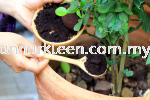Plant Fertilizing
| Previous | 5 / 9 | Next |
- plant fertilizing services malaysia
- Landscape Service Johor
- Landscape Service Senai
- Landscape Maintenance JB
- Landscape Maintenance Kulai
Plants are dependent on specific nutrients to support healthy growth and development. There are several types of fertilizers, including organic, inorganic, and synthetic fertilizers. Most contain one or more of the four main plant nutrients - nitrogen, phosphorus, and potassium. They also contain other micronutrients that are essential for plant growth. Plants naturally obtain these nutrients from the ecosystem, other plants, bacteria, and dead organisms.
Fertilizers come in different formulations and are applied to the soil in different methods. The amount and frequency of application depend on the type of plant and its needs. It is essential to understand the nutrient requirements of your plants so that you can use the right fertilizer for them.
A common type of fertilizer contains phosphorus, potassium, and nitrogen. These are the three most important plant nutrients. These are also known as NPK. The amounts of each are listed on the fertilizer bag. To make sure you're getting the right amount, read the label. There should be at least three numbers on the bag. These are the percentage of nitrogen, phosphorus, and potassium that the fertilizer contains.
Another type of fertilizer is known as slow-release or soluble fertilizers. Soluble fertilizers are dissolved in water and then applied to the soil. Soluble fertilizers tend to have high concentrations, and these nutrients build up in the soil. As a result, plant roots struggle to absorb water, resulting in root disease and damping-off. In addition, soluble fertilizers tend to cause a crust on the soil surface.

